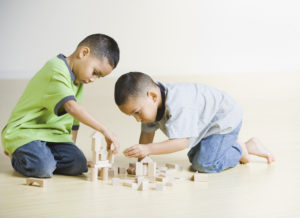 Ask most parents who have more than one child and they will tell you how completely different they are from one another. Each child has his or her own unique style.
Ask most parents who have more than one child and they will tell you how completely different they are from one another. Each child has his or her own unique style.
One might be energetic, outgoing and inquisitive while another might be reserved and reflective. So what do parents and other caregivers need in order to navigate these differences? What can you do to help them respond to their child’s individual needs?
As a first step, you can help caregivers identify and understand their child’s style or temperament. This can help prepare caregivers for what might happen in situations that may be difficult or unfamiliar and respond to their children in ways that promote positive outcomes. Understanding a child’s style or temperament is foundational to their social and emotional development, supports their development across all domains, and is important to any outcome that you may be working on with a child and family.
Children typically fall into one of three temperament categories, adaptable, cautious, and feisty (Zero to Three). Chances are you have work ed with families whose children fall into each of these three styles.The adaptable child is flexible, typically has regular routines, handles transitions easily, adapts well to new situations and may communicate with caregivers in subtle ways. The cautious child needs more time to warm up to new objects, people or situations, they tend to be more thoughtful and may appear withdrawn, adapting more slowly. The feisty child is active, lets you know what they need, has intense feelings, is easily distracted, and can have difficulty controlling their feelings. It is important to note that while most children fall into one of these three categories some children are a blend of more than one style.
ed with families whose children fall into each of these three styles.The adaptable child is flexible, typically has regular routines, handles transitions easily, adapts well to new situations and may communicate with caregivers in subtle ways. The cautious child needs more time to warm up to new objects, people or situations, they tend to be more thoughtful and may appear withdrawn, adapting more slowly. The feisty child is active, lets you know what they need, has intense feelings, is easily distracted, and can have difficulty controlling their feelings. It is important to note that while most children fall into one of these three categories some children are a blend of more than one style.
Knowing these different temperament types is helpful but we need more information to better understand the temperament of individual children. Stella Chess, M.D. identified nine temperament traits that occur at different levels and intensities and help us understand how these traits fit into each temperament type. By observing children across time and in different situations you can learn more about children’s unique traits and ultimately about their individual styles.
Finally, as adults, we don’t often think about our own style or how that impacts the children we care for. You can help parents and other caregivers be aware of their own style, understand the similarities and differences between their style and their child’s style and how they can be a better match for their child’s style. For example, you might help them learn how to slow down or take a little more time with a child who is slow to warm.
Take a look at the following scenario to learn more about the nine temperament traits and how they give us clues to the styles of individual children. Then try out The Temperament Assessment Scale for Children with one of the families you are working with. Check back here and leave a comment to let us know how it went!
Your Temperament Assessment Scale, a temperament scale assessment for adults is available from the Program for Infant Toddler Care (PITC). For more information on this topic check out the Center for Early Childhood Mental Health and the Infant Toddler Temperament Tool. You can find both of these resources on the Social Emotional Resource for Families page on the EITA Portal.
References:
Zero To Three, Matching Your Infant’s or Toddler’s Style to the Right Child Care Setting, Retrieved from https://www.zerotothree.org/resources/86-matching-your-infant-s-or-toddler-s-style-to-the-right-child-care-setting
Program for Infant Toddler Care (PITC), Temperament: A Practical Approach to Meeting Individual Needs, Retrieved from: https://www.pitc.org/cs/pitctr/view/pitc_res_wkshp/20
